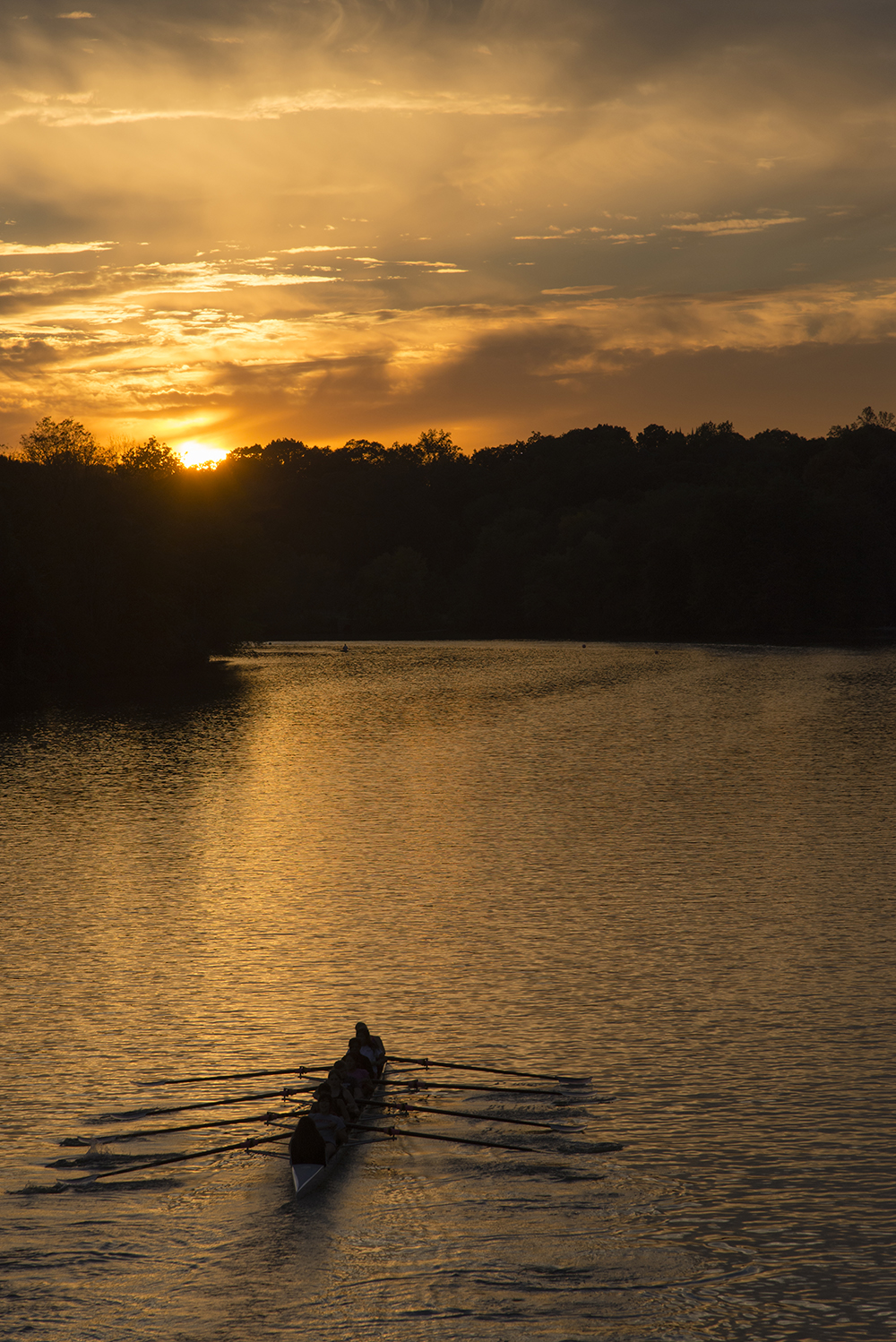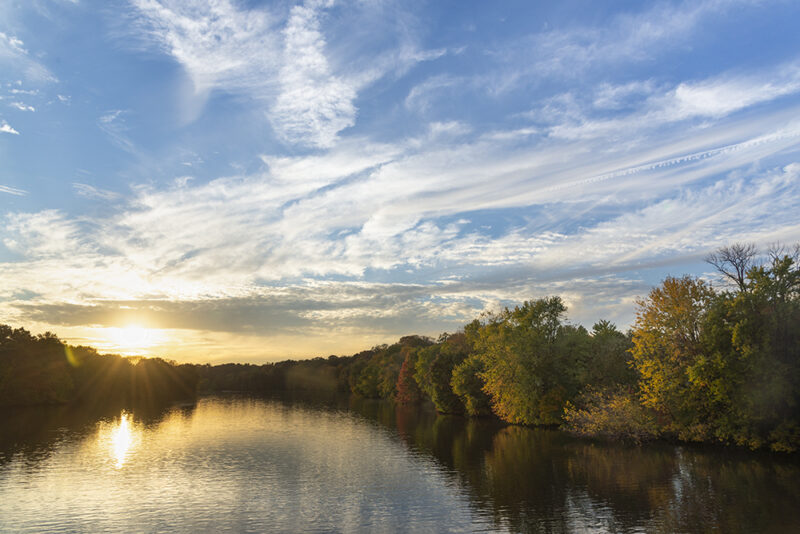Lake Carnegie
A Princeton Treasure
By Laurie Pellichero | Photography by Charles R. Plohn

Andrew Carnegie portrait by Howard Russell Butler. (Andrew Carnegie Birthplace Museum, Scotland)
It all began with a portrait. In 1902, steel magnate and noted philanthropist Andrew Carnegie was posing for painter Howard Russell Butler, Princeton University Class of 1876, when Carnegie brought up the many lochs he had built in his native Scotland. Butler, a former member of the University rowing team, took the opportunity to inform Carnegie of the cramped rowing conditions along the Delaware and Raritan Canal, where the team practiced but also had to deal with freight traffic traveling between New York and Philadelphia. This had forced the rowing program to disband in 1886.
Butler suggested a building a dam at the confluence of the Millstone River and Stony Brook, which would flood the swamps around the Washington Road Bridge, creating a reservoir that would be a much better option for the University’s team. According to Princetoniana, it was an idea that Carnegie quickly embraced.
Butler then consulted with a New York engineering firm, which determined that a lake could be constructed for $118,000.
Carnegie visited the site, and soon after authorized funds for the lake. The land for its basin was purchased from various owners in 1903, and by 1905 enough was secured for crews to begin clearing the property and constructing the dam. Lake Carnegie’s official opening was on December 5, 1906, with Carnegie in attendance.
It was the first lake in the U.S. built specifically to create a course for competitive rowing. It turns out that the cost for construction was greatly underestimated, and the final tally was about $450,000. The rowing program began again in 1911.

Workers building a dam on the Millstone River near Kingston to create Lake Carnegie. (Historical Society of Princeton)
Carnegie (1835-1919) was among the wealthiest and most famous industrialists of his day. Born in Dunfermline, Scotland, he emigrated to America at age 13 with his parents and younger brother. The family settled in Allegheny, Pa., and young Andrew helped to support them by working long hours as a bobbin boy in a cotton mill for $1.20 a week. He was later hired as a messenger for a local telegraph company, where he taught himself to use the equipment and was promoted to telegraph operator. According to the Carnegie Corporation, with this skill he got a job with the Pennsylvania Railroad, where he was promoted to superintendent by age 24.
Carnegie was a voracious reader and took advantage of the generosity of Allegheny resident Col. James Anderson, who opened his library to local working boys. Books provided most of his education, and by the 1860s he had investments in railroads, railroad sleeping cars, iron works, steamers, and oil rigs. He built further wealth as a bond salesman, and built Pittsburgh’s Carnegie Steel Company, the largest steel manufacturer in the world at the time, which he sold to J.P. Morgan in 1901 for $480 million (billions in today’s dollars).
A longtime philanthropist, during the last 18 years of his life he gave away around $350 million to numerous charities, foundations, and universities, among others. After his death, his remaining fortune was endowed to the Carnegie Corporation of New York to be used principally to promote education and international peace.

A family on a dock at Lake Carnegie. (Historical Society of Princeton)
According to carnegie.org, one of the most tangible examples of Carnegie’s philanthropy was the founding of 2,509 libraries in the late 18th and early 19th centuries. Of these libraries, 1,679 were built in the United States. Carnegie spent over $55 million of his wealth on libraries alone, and he is often referred to as the “Patron Saint of Libraries.”
In addition, he paid for thousands of church organs in the U.S. and around the world.
The 238-acre Lake Carnegie, one of his many gifts, was initially owned by a nonprofit organization, but it was deeded to Princeton University in 1934. But, notes Princetoniana, its construction was not yet complete. Its shallowness, sometimes as low as four feet, led to silting and subsequent flooding, and the lake was dredged three times in its first 65 years, and most recently in 2019. The dam has also been reinforced.

The Class of 1887 Boathouse at Lake Carnegie. (Historical Society of Princeton)
Today, Lake Carnegie, which bounds the south end of the Princeton University Campus, is not only home to the University’s rowing teams, but is also one of Princeton’s most open and natural spaces. It is also a resource for the local community and a home to abundant wildlife. The Washington Road Bridge and Harrison Street Bridge cross it and provide picturesque views.
According to princeton.edu, the lake extends for nearly four miles, curving away from campus towards Kingston. The Delaware and Raritan Canal State Park towpath runs the length of the lake’s south shore. The north shore is home to the University’s C. Bernard Shea Rowing Center — which consists of the Class of 1887 Boathouse and the Richard Ottesen Prentke ’67 Training Center — along with a trail, woodlands, and private residences.
The boathouse was a gift of the Princeton University Class of 1887 at its 25th reunion in 1912, with construction beginning in 1913. The Shea Center was dedicated on October 7, 2000, and features state-of-the-art facilities and equipment.

Men rowing on Lake Carnegie. (Historical Society of Princeton)
The men’s and women’s rowing teams use the lake to train and host competitions with other universities. It is also used as a training site for Olympic rowers, and hosted the U.S. Olympic trials in 1928, 1936, and 1948.
“There is nothing like having a lake on campus — no other university owns its own lake,” says Lori Dauphiny, head coach of the Princeton University Open Women’s Rowing Team. “We can run practices and races when we need to — it is such a great advantage. The U.S. National Team also trains here. It is the best training ground in the country. We all benefit from the facility and the lake. A lot of people come to watch the rowers. It really brings people together — it is a unifying element in the community.”
“There is so much nature at the lake,” she adds. “This morning I saw two eagles in one tree, along with blue herons and turtles. It’s a great place for kayakers and fishermen. It’s also the best office I could ever have.”

Photography by Charles R. Plohn
Greg Hughes, PU Class of 1996 and head coach of Heavyweight Men’s Rowing, says, “Princeton Rowing is exceptionally fortunate to have Lake Carnegie as the home for our program. The lake is perfect for our sport. It is well protected from wind and weather, allowing for calm water for training. It is the best place in the U.S. for rowing, and that is why you see our U.S. Olympic Teams choose Carnegie for their training as well. What’s more, it is right on campus, so our athletes have quick, easy access to the boathouse and the lake.”
“For me, I feel incredibly lucky to have such an amazing ‘office,’ adds Hughes. “Each day I spend hours out on Carnegie taking it all in. It is a beautiful spot and we are very lucky to have such a great natural resource right here in our community.”
While Lake Carnegie is owned and maintained by the University, the public is welcome to use it for rowing, kayaking, canoeing, fishing, or walks along its shores. Community access to the lake is available at the boat launch area adjacent to Route 27 just south of Kingston. The boat launch area is open from dawn to dusk.
Anglers can find a variety of fish including carp, channel catfish, largemouth bass, tiger muskie, yellow perch, and sometimes brown and rainbow trout. Swimming is not allowed in the lake, nor are gas-powered boats.
Albert Einstein was one of the lake’s many users, and often sailed with close friend and University librarian Johanna Fantova, who kept a diary of their conversations that is available in the Princeton University Library’s Department of Rare Books and Special Collections. She once wrote, “Seldom did I see him so gay and in so light a mood as in this strangely primitive little boat.”
Lake Carnegie has also been used for ice skating, hockey, or walking when it freezes in the winter, but it has been many years since the ice has thickened enough for safe activity.
Numerous bird species can be found at the lake at various times of the year, including bald eagles, swans, seagulls, Canada geese, great blue herons, egrets, double-crested cormorants, mergansers, red-winged blackbirds, and woodpeckers.
Lake Carnegie also contains several islands. They are not accessible to people, but provide habitat to numerous animals including deer, beavers, turtles, and foxes.
In 1990, the Lake Carnegie Historic District was listed on the National Register of Historic Places, and Carnegie’s gift continues to be special place for sports, recreation, and relaxation for students, residents, and visitors alike.
As a group of students sang to Andrew Carnegie at the lake’s opening ceremony in 1906:
Carnegie, Carnegie
He is giving us a lake
You can hear the breakers break;
Carnegie, Carnegie
Andy, Andy, you’re a dandy
Carnegie.


